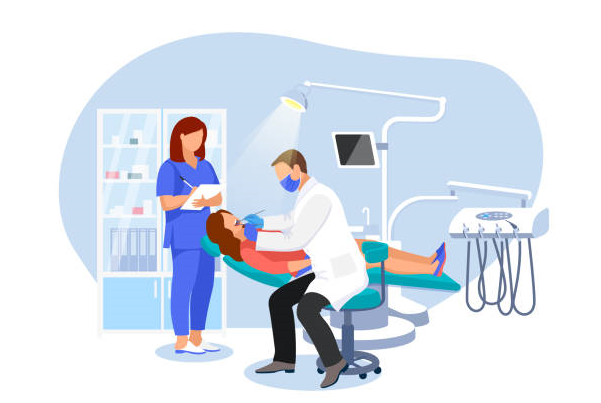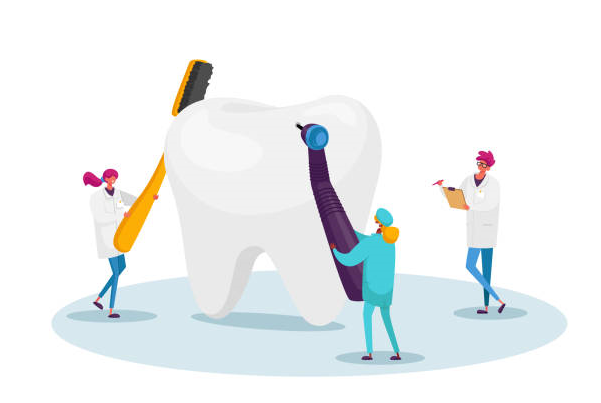Emergency conditions in Dental Clinics
Faint - due to Pain or anxiety.
Signs and symptoms
• May be preceded by nausea and closing in of visual fields
• Pallor and sweating
• Heart rate below 60 beats/min (bradycardia) during attack.
T/t
• Give oxygen
• Expect prompt recovery.
• Need to encourage oxygenated blood flow to brain as rapidly as possible
• May need to block vagal activity with atropine and allow heart rate to increase.
If the patient is slow to recover, consider other diagnosis or give 0.3-1 mg atropine i.v.
Hyperventilation- due to Anxiety
Signs and symptoms
• Light-headed
• Tingling in the extremities
• Muscle spasm may lead to characteristic finger position (carpopedal spasm).
Treatment
• Reassure
• Ask patient to re-breathe from cupped hands or reservoir bag of inhalational sedation or general anaesthetic apparatus.
• Reduce anxiety
• Over-breathing has blown off carbon dioxide, resulting in brain blood vessel vasoconstriction. Return carbon dioxide levels in blood to normal.
Postural hypotension- More likely to occur if the patient is taking betablockers,which reduce the capacity to compensate for normal cardiovascular postural changes.
Signs and symptoms
• Light-headed
• Dizzy
• Loss of consciousness on returning to upright or standing position from supine position.
Treatment
Lay the patient flat and give oxygen
Sit the patient up very slowly.
Encourage oxygenated blood flow to brain.
Diabetic emergencies: hypoglycaemia- Patient may have taken medication as normal but not eaten before dental visit.
Signs and symptoms
• Shaking and trembling
• Sweating
• Hunger
• Headache and confusion.
Treatment
• If the patient is conscious, give three sugar lumps or glucose and a little water or glucose oral gel; repeated if necessary in 10 minutes
• If the patient is unconscious, inject 1 mg (1 unit) glucagon by any route (subcutaneous, intramuscular or i.v.).
Return blood glucose level to normal by giving glucose or by converting the patient's own glycogen to glucose by giving glucagon.
Further management
• Transfer the patient to A&E
• Give up to 50 ml 20% glucose i.v. infusion followed by 0.9% saline flush as the glucose damages the vein
• Expect prompt recovery.
Grand mal epileptic seizure- Usually the patient is a known epileptic
• Epilepsy may not be well controlled
• Seizure may be initiated by anxiety or by flickering light tube.
Signs and symptoms
- Sudden loss of consciousness associated with tonic phase in which there is sustained muscular contraction affecting all muscles, including respiratory and mastication
- Breathing may cease and the patient becomes cyanosed
- The tongue may be bitten and incontinence occur After about 30 seconds, a clonic phase supervenes, with violent jerking movements of limbs and trunk.
Treatment• Ensure patient is not at risk of injury during the convulsions but do not attempt to restrain convulsive movements
• Make no attempt to put anything in mouth or between the teeth
• After movements have subsided, place the patient in the recovery position and check airway
• The patient may be confused after the fit: reassure and offer sympathy
• After full recovery, send the patient home unless the seizure was atypical or prolonged or injury occurred.
• Maintain oxygenated blood to brain
• Protect from physical harm
• Administer anticonvulsant.
Further management
Risk of brain damage is increased with length of attack; therefore, treatment should aim to terminate seizure as soon as possible.
If convulsive seizures continue for 15 minutes or longer or are repeated rapidly (status epilepticus):
• transfer to A&E
• remove dentures, insert Guedel or nasopharyngeal airway
• give oxygen
• give 10-20 mg i.v. diazepam (2.5 mg/30 s) as Diazemuls but beware of respiratory depression, or diazepam solution for rectal administration in hospital.




 EET MDS
EET MDS